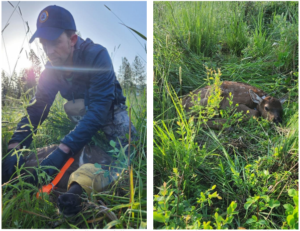Researchers are using GPS collars and trail cameras to get a better grasp on the elk population in northwest Montana. The three-year study is a collaborative effort by researchers at the University of Montana and Montana Fish (FWP), Wildlife & Parks, and funded in part by the Rocky Mountain Elk Foundation.
The goals of the study are to “monitor elk movements, carnivore distributions, habitat conditions, and hunter access and develop elk distribution models that incorporate both the effects of timber harvest management and hunter access.” Doing so will supply information for biologists to better understand and manage the immediate elk population and perhaps apply some of their findings for elk management in other parts of Montana.
A September update of the study shows researchers captured and placed collars on 71 elk from December 2022 to March 2023 as well as 25 elk calves during the spring. They also captured and collared three mountain lions and three black bears, plus they monitored the movement of a wolf previously collared during the 2022 summer to learn more about elk predation. When an elk collar transmits a mortality signal, researchers retrieve it and examine the kill site for tracks and cause of death.
“We can swab the bites for saliva to see what animal made them,” Zack Farley, FWP biologist, told the Sanders County Ledger.
Researchers also found elk generally tend to spend time in thickly wooded areas with limited access during archery and rifle hunting seasons.
(Photo credit: Montana Fish, Wildlife & Parks)

